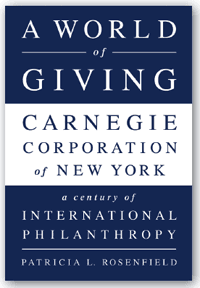
A World of Giving: Carnegie Corporation of New York - A Century of International Philanthropy
Patricia L. Rosenfield
738 pages, Public Affairs, 2014
A World of Giving, by Patricia L. Rosenfield, is a very long book that tells a straightforward story of experimentation and evolution in philanthropy. Thoroughly researched and abundantly footnoted, the book chronicles the development of the Carnegie Corporation—Andrew Carnegie’s most important institutional legacy—from its early years to the present. The corporation began with a broad mission to “promote the advancement and diffusion of knowledge and understanding,” and Rosenfield imposes a strong sense of order on the vast range of activities that have defined its work to fulfill that mission.
Rosenfield doesn’t try to be original in how she organizes the book. She does not, for example, deploy clever crosscutting themes or recurring ideas that might illuminate the philanthropic territory that the corporation has traversed. Instead, she adopts a crisp and easy-to-follow structure that breaks the Carnegie storyline into eight periods that extend from 1911 to the present. She begins by discussing some of the confusion and struggle that characterized the corporation in its early days: Carnegie had three presidents in its first four years of operation. Then, after moving through periods of by increasing engagement with pressing global challenges, she shifts to the story of several leaders who left their distinctive mark on the foundation.
One strength of the book is that it captures how Carnegie’s 12 presidents have shaped the foundation’s gentle evolution. Consider Frederick Keppel (1923-1941), who pushed the corporation boldly in a more international direction, or Alan Pifer (1967-1982), who helped professionalize the foundation and open it up to a variety of stakeholders. Later, David A. Hamburg (1982-1997) and Vartan Gregorian (1997-the present) continued their predecessors’ commitment to building a global community of changemakers. Rosenfield ably conveys the importance of leadership in foundations—even though Carnegie, like most of its peers, generally operates in the world at a distance and through its grantees.
Readers who are looking for a tough, analytical approach to the history of a prominent American foundation will find the book somewhat frustrating. It reads at times like a century-long annual report produced by a longtime insider. Rosenfeld starts and ends with the claim that effective foundation giving involves four elements: “significance of mission”; “openness to risk-taking”; “willingness to make long-term investments”; and “openness to collaboration and partnership.” For a book that devotes 738 pages to the history of one institution, that set of ideas can only be described as a rather modest collection of takeaways.
There’s nothing wrong with Rosenfield’s narrative approach. At times, though, the book comes across as over-supportive of the Carnegie Corporation—not in a cheerleading way, but in the sense that Rosenfield never really asks tough questions about accountability. She identifies a few obvious missteps, but on the whole her account focuses on recounting the lofty intentions, grand plans, and complex agendas that Carnegie leaders have pursued. The book contains surprisingly little discussion of the actual outcomes that resulted from corporation giving.
Dispassionately and in great detail, Rosenfield describes the support provided by the Carnegie Corporation to a wide range of ideas, organizations, and movements: Russian studies programs, the National Bureau for Economic Research, development in Africa, international conflict resolution, the Institute for International Education, the Carnegie Endowment for International Peace, Caribbean women’s empowerment, and on and on and on. In the few cases when Carnegie engaged in active institution creation, its impact seems real enough. But in most other cases, its giving is only a drop in the river of global foundation funding.
Overall, Rosenfield treads lightly when it comes to giving the corporation credit for what its grantees have accomplished. Another reason for doing so is that Carnegie has frequently acted in partnership with other institutions. As Rosenfield shows, the corporation has collaborated extensively with the Rockefeller and Ford foundations, along with many other funders.
The scholarship on private foundations takes various forms. There are biographies of the great donors, like Ron Chernow’s Titan: The Life of John D. Rockefeller Sr. There are critical assessments of the field and its assumptions, like Mark Dowie’s American Foundations. There are sweeping histories of the entire field, like Judith Sealander’s Private Wealth and Public Life. The history of a single institution is ultimately a more constraining form because it provides little scope for the intimate details of a biography, the bite of a generalized critique, or the thematic integration of a broad historical narrative.
Within the confines of its approach, however, A World of Giving presents a solid and comprehensive account of the Carnegie Corporation’s institutional development. Even if it never approaches being a page-turner, the book delivers a masterfully organized array of details regarding the ideas, grants, and initiatives that constitute the foundation’s pursuit of Andrew Carnegie’s open-ended mandate.

